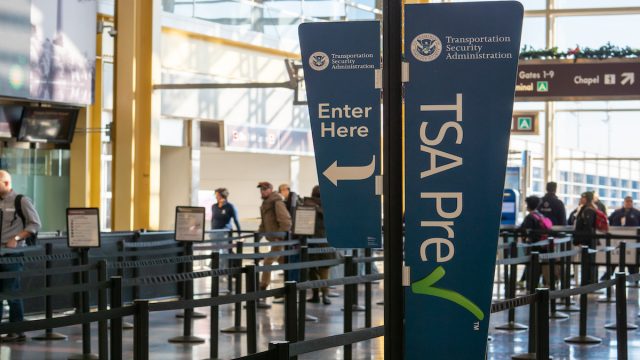19 Airport Security Checkpoints Allow Flyers to Make Advance Reservations

Wait times, from the line at baggage drop-off to the lines at airport security, are one of the most stressful parts of flying (or just making your flight or connection). But government agencies are looking into more ways to speed things up so that passengers aren’t stuck in interminable, winding lines.
In 2008, the U.S. Customs and Border Protection rolled out Global Entry, which allows pre-approved passengers to enter to “bypass traditional CBP inspection lines.” In 2013, the Transportation Security Administration (TSA) debuted its PreCheck program, which hit 10 million members in 2020 and allows members to avoid “removing shoes, laptops, 3-1-1 liquids, belts or light jackets at security checkpoints.” And TSA also started expanding on its rollout of biometric facial recognition, which has been somewhat controversial, to speed up security lines earlier this year.
Following its launch in 2021, Reserve, a security line reservation tool powered by the biometric security company Clear, is officially available at 19 airports across the world. With summer being one of the most popular times to travel, more and more U.S. airports are implementing Reserve to optimize security checkpoint wait times.
The booking feature allows flyers to save their spot in a security line in advance and is considered a more viable option to the Clear Plus program, which runs $189 per year. Reserve on the other hand is totally free.
“Travelers can now save even more time by seamlessly reserving their spot in the security line,” Kasra Moshkani, CLEAR’s Executive Vice President of Operations, said in a statement to Travel + Leisure.
READ THIS NEXT: 9 Secret Travel Hacks Flight Attendants Always Use.
Orlando International Airport was the first airport to offer Reserve. Now, travelers can take advantage of the reservations-only lane at Los Angeles International Airport, Minneapolis Minneapolis−Saint Paul International Airport, John F. Kennedy International Airport, Newark Liberty International Airport, Phoenix Sky Harbor International Airport, Denver International Airport, and Seattle-Tacoma International Airport, per Travel + Leisure. Several international airports are hopping on the Reserve bandwagon too, including Amsterdam Airport Schiphol, Vancouver International Airport, and Berlin Airport (BER Runway).
So, how does Reserve work? Travelers can reserve their spot in line by visiting the Reserve website and selecting their airport of departure. A reservation form will ask you to provide your destination, airline, flight number, party size, and passenger(s) information. Reservations are available in window increments of 20 minutes. For example, if you have a late-morning flight, you can reserve a spot in line for 9:00 a.m. to 9:20 a.m. Once booked, you will receive a QR code with your reservation information that will you will need present to the Transportation Security Administration (TSA) agent.
It’s important to note that the Reserve lane follows standard security protocol, so shoes, belts, and hats still need to be removed. The same rules apply for electronics and liquids. Additionally, you still need to show your boarding pass and identification documents to TSA officials.
The Reserve lane is one of a number of new technologies and strategies that airports are testing out to alleviate the stress of getting through security checkpoints at airports.